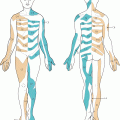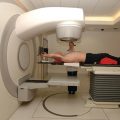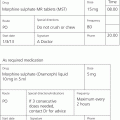Chapter 7 Sing Yu Moorcraft The Royal Marsden NHS Foundation Trust, UK The normal range of total calcium is usually 2.12–2.65 mmol/L (8–10 mg/dl). Hypocalcaemia is defined as a low concentration of calcium in the blood. The grade of hypocalcaemia is shown in Table 7.1. Table 7.1 CTCAE (V4.03) grading of hypocalcaemia. From the website of the National Cancer Institute (http://www.cancer.gov). LLN = lower limit of normal. This is when variation in protein concentrations (particularly albumin) leads to fluctuations in total calcium level, but ionised calcium levels remain relatively stable. For example, patients with chronic illnesses such as cancer can have a low total plasma calcium but normal ionised calcium. Therefore calcium levels should be corrected for albumin as follows: corrected calcium (mmol/L) = measured calcium (mmol/L) + 0.02 * (40 – patient’s albumin (g/L)). The normal range of potassium is usually 3.5–5.0 mmol/L. Hyperkalaemia is defined as an elevated concentration of potassium in the blood. The grade of hyperkalaemia is shown in Table 7.2. Table 7.2 CTCAE (V4.03) grading of hyperkalaemia. From the website of the National Cancer Institute (http://www.cancer.gov). ULN = upper limit of normal. Hypokalaemia is defined as a low concentration of potassium in the blood. The grade of hypokalaemia is shown in Table 7.3. Table 7.3 CTCAE (V4.03) grading of hypokalaemia. From the website of the National Cancer Institute (http://www.cancer.gov). LLN = lower limit of normal.
Electrolyte abnormalities
Hypocalcaemia
Grade
Criteria
1
Corrected serum calcium of < LLN – 8.0 mg/dL; < LLN – 2.0 mmol/L; ionised calcium < LLN – 1.0 mmol/L.
2
Corrected serum calcium of < 8.0–7.0 mg/dL; < 2.0–1.75 mmol/L; ionised calcium < 1.0–0.9 mmol/L; symptomatic.
3
Corrected serum calcium of < 7.0–6.0 mg/dL; < 1.75–1.5 mmol/L; ionised calcium < 0.9–0.8 mmol/L; hospitalisation indicated.
4
Corrected serum calcium of < 6.0 mg/dL; < 1.5 mmol/L; ionised calcium < 0.8 mmol/L; life-threatening consequences.
5
Death.
Pseudohypocalcaemia
Symptoms/signs
Causes
Management
Other relevant sections of this book
References
Hyperkalaemia and hypokalaemia
Hyperkalaemia
Grade
Criteria
1
> ULN – 5.5 mmol/L.
2
> 5.5–6.0 mmol/L.
3
> 6.0–7.0 mmol/L; hospitalisation indicated.
4
> 7.0 mmol/L; life-threatening consequences.
5
Death.
Symptoms/signs
Causes
Management
Hypokalaemia
Grade
Criteria
1
< LLN – 3.0 mmol/L.
2
< LLN – 3.0 mmol/L; symptomatic; intervention indicated.
3
< 3.0–2.5 mmol/L; hospitalisation indicated.
4
< 2.5 mmol/L; life-threatening consequences.
5
Death.
Symptoms/signs
Causes
Management
Stay updated, free articles. Join our Telegram channel

Full access? Get Clinical Tree






